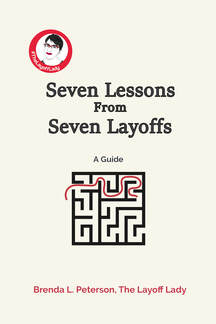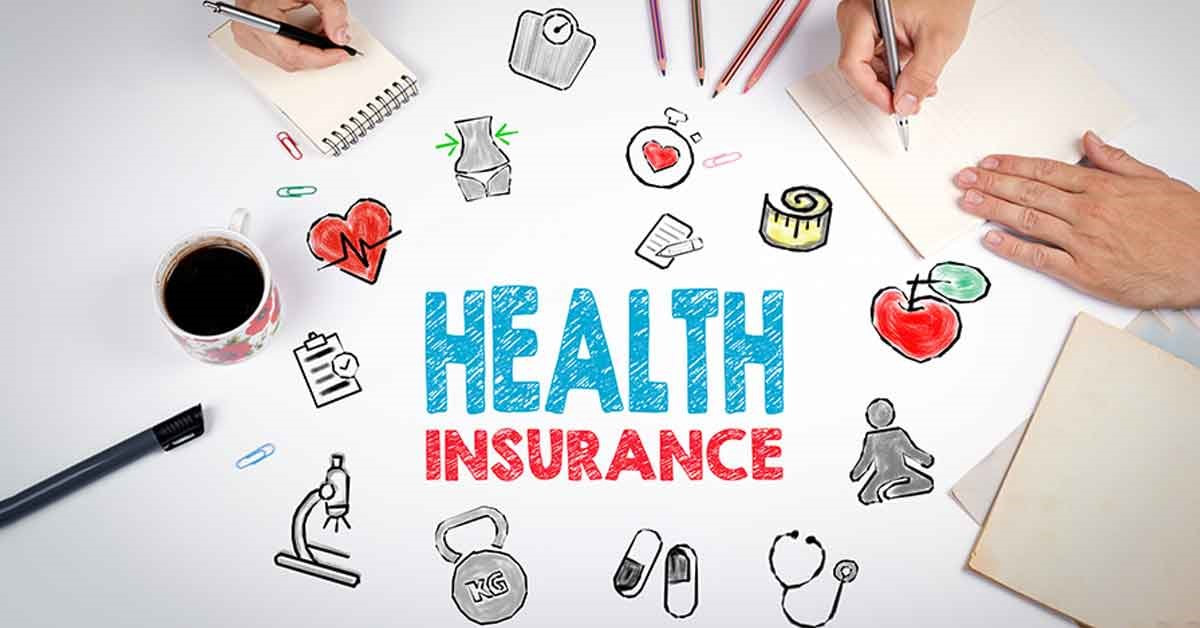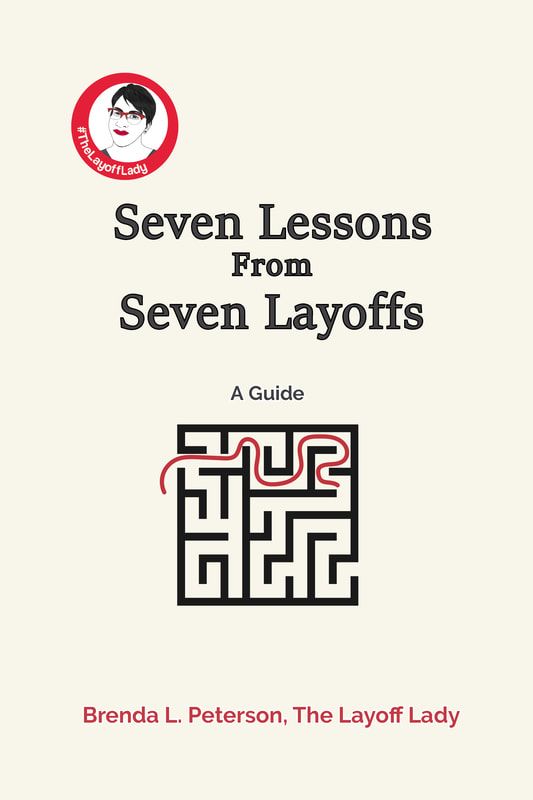|
By Brenda L. Peterson, The Layoff Lady About The Seven Layoff LessonsThrough my seven layoffs and many conversations with others in post-layoff career transition, I have learned seven core lessons:
About Lesson Two: Keep Your Mind on Your Money (and your money on your mind).Most people work to pay their bills and afford the life they want. Unfortunately, when your job ends, so does your main income stream—and possibly your health insurance, too. Making the right short-term changes can help you weather the storm while also minimizing long-term financial repercussions. Let’s look at a few key components of this lesson. Post-Layoff ChangesAfter a layoff, many things in your financial life change. Now, you don’t know when your next paycheck will arrive or how much it might be. However, you do know that you need to figure out how to survive financially from now until that unknown future date. As you wrestle with uncertainty, you need to research options, run the numbers, and make the right decision for your household. New Financial GoalsNext, it’s important to adopt new interim financial goals. Now, the focus is not on getting ahead or progressing toward larger goals. Instead, your overarching goal is to live through your period of unemployment until you are gainfully employed again with as little long-term financial trauma as possible. Career Transition Income SourcesWith your day job gone, chances are your core source of income just evaporated. Instead, you’ll get one last paycheck. Your check may be a little larger than usual if you get a vacation payout and a little bigger still if they don’t deduct anything for the benefits you won’t have anymore. Depending on your situation, you might also get a severance payment—which could be any amount between a fat lot of nothing and the equivalent of several months of income. In most cases, when your job ends due to a layoff, you will be eligible for unemployment insurance (UI) benefits. UI replaces a portion of your employed income—which will most likely be significantly less than your previous paycheck. There are multiple ways to help fund your life varying from good to decidedly bad ideas. These could include using your savings, taking on short-term work, or incurring additional debt. Career Transition HealthcareWhile you’re working, your health insurance has a pretty good chance of being connected to your day job, and your employer may even pay a portion of your costs. When your job ends, you have a lot of decisions to make. You can continue your current health care coverage with a significantly higher cost, usually referred to as COBRA. If possible, you could become a dependent on someone else’s coverage or find a plan on Healthcare.gov. Alternatively, you could enroll in a lower-cost short-term health plan or find other ways to pay for healthcare costs. When it comes down to it, it’s essential to consider the short and long-term implications of your healthcare decisions—especially since having an unexpected health expense can cause severe financial hardship. Career Transition ExpensesUnfortunately, while your regularly scheduled income goes away, your expenses generally do not. Now, it’s more a matter of adjusting your priorities and seeing what you can do to streamline your layoff survival budget. When times are tight, you will need to make more calculated decisions regarding where you spend money. Line items like rent, car payments, and utilities may be non-negotiable, while you may need to pare down what you spend on non-essential expenses like entertainment and restaurants. As you work to minimize expenses, this is another area where making shortsighted decisions can cause long-term problems. You also need to make sure you still take part in activities that make you happy, even with less discretionary income. When Income and Expenses Don't Line UpOne of the harsh realities of career transition is that your current income may be significantly lower than your outgo. In these cases, you may need to take on additional work or incur some debt. If you can’t pay your bills, contact the company and discuss options. While it can be humbling, it’s better than damaging your credit score, which can negatively impact your financial life for years to come. For The Whole StoryFor all the information on each of the seven lessons pick up a copy of my book Seven Lessons From Seven Layoffs: A Guide. Learn More
0 Comments
By Brenda L. Peterson, The Layoff Lady Layoffs Happen All The TimeIt starts like any other day. Then, it takes an ominous turn. Whether you were invited to an ambiguously titled last minute meeting, received an awkward email in your personal email notifying you of your last day, or are perp walked to HR on your first day back from vacation, you are now among the newly unemployed. Welcome to the suck. Now What Do I Do?Even if there were buyout rumors, a quarter with low sales, or a new company direction, being part of a reduction in force (RIF) is still surreal when it happens to you. It's hard to know what to do with yourself when you find yourself unexpectedly out of the job. It's time to redirect your attention. Your New Focus AreasThe work problems you had an hour ago are gone. Along with your freed-up future come very different challenges. It’s time to shift to these top three focus areas:
Your Guiding PrincipleAlong with your new focus areas, your overall guiding principle is not to do anything counterproductive (or downright dumb) as you figure out your post-layoff next steps. Your Never-Do List Here are the career-limiting moves that will make your life harder. Instead of springing into action, stop, think, and then just don't do the following:
Your Think-Before-You-Consider-Doing List Here are a few things you may want to do at some point, but that require thought and a plan before you move forward. At the very least, sleep on it before you do any of the following:
Now that you are at least somewhat inoculated against creating utter chaos for yourself, let's get back to those top three focus areas. Focus Area 1: Process Your EmotionsLosing your job can be an emotional roller coaster. An unplanned job change is a stressful life event on par with getting divorced or going to prison. Just like dealing with a death in the family, you’re dealing with the death of the future you thought you had. Losing that imagined future is a significant loss that needs to be addressed. Figure out how you will cope with these changes. While distracting yourself from the unpleasant parts of the process is natural, building healthier coping mechanisms, like prioritizing self-care, is better for your long-term success. While you can get away with avoiding your feelings for a while, eventually, you need to acknowledge each one so you can move on. If you don’t work through those difficult emotions, your ignored feelings will come out sideways at just the wrong time. It is better to work through your grief privately than to fall apart during an interview or snap at someone who is trying to help you. Step 2: Review Your FinancesDisclaimer: While I know quite a bit based on my previous work experience supporting financial coaches, my own research, and my personal life experiences, I do not currently hold a license or certification to give financial advice. Therefore, the information provided here is educational information provided as guidance. I hope you can glean value from my lessons learned. Feel free to take my recommendations or not—but whatever you do, double-check my information (and everyone's facts, for that matter). This is your life, and you will care more about your finances and health care than anyone else. With that, read on. Possible Money From Your Former EmployerAlthough your paychecks will eventually stop, you will receive your final paycheck, possibly vacation time that you have earned and, hopefully, a lovely parting gift from your former employer in the form of a severance package. Severance could be equivalent to a set number of weeks of pay or include an additional lump sum, continuation of some benefits, and job placement services. In most cases, employers do not have to give you any type of severance. If you are eligible for a severance package, you will need to sign something before receiving that money. Once you sign, any thoughts you might have about legal action regarding your employment with the organization are pretty much over. Read the agreement given to you, consider having a lawyer look it over, and ask for clarifications (and any revisions) before signing it. After that, there is typically a waiting period before you receive that money. I also encourage you not just to sign whatever paper they put in front of you. Make sure you advocate for yourself. Unemployment IncomeAfter a layoff, most people will be eligible for unemployment insurance income, or UI. I encourage you to apply for unemployment payments. The money used to make unemployment payments comes from the payroll taxes that employers pay. That money is intended to help people who have been laid off to pay their bills as they search for something new. Unemployment payments are administered at the state level and vary by state. After you apply, there may be a waiting period before you receive a payment. Your state will also outline the amount of each payment you will receive, the number of payments you are eligible to receive, and additional factors impacting your payments. You may also qualify for job search support services and even programs to help you upgrade your skills. In short, apply for unemployment income right away. In most cases, there is not a good reason for most people to forgo unemployment payments. A Note About Health InsuranceSince many people rely on their employers for health insurance coverage, consider how you’ll cover healthcare costs. If you have a spouse, domestic partner, or parent who can bring you onto their health insurance, that may be your best option. Check with the other person’s employer and let them know you no longer have health insurance through your employer because of a layoff. Their employer can talk you through your next steps and cost changes. If that's not an option, consider COBRA coverage through your former employer. This means you could stay with your previous health insurance, but now you'd pay the whole premium cost. Brace yourself when you see your new premium amount because it is usually A LOT more than you spent as an employee. Another option is going on the insurance exchanges at Healthcare.gov to find coverage. You may even be eligible for a subsidy to offset the cost. Alternatively, for less expensive coverage intended to cover a big expensive medical issue should it happen, short-term health care insurance may be a good interim option. Do your research and determine what makes the most sense for you and your household. Step 3: Prepare For Your Job SearchNext, plan to launch your search for a new job. Start by thinking about what kind of job you want. Write down job titles, possible employers, and your target salary range. Update your resume to include details about your last position and showcase your unique skillset as it aligns with your target job. From here, start letting people know your new status of being “in transition” and ask for help. They might be able to introduce you to a valuable business contact, keep an eye out for job openings that meet your needs, and introduce you to a hiring manager looking for someone just like you. It Will All Work Out. It May Also Take A While.All told, I’ve had seven workdays that started with lots of obligations then quickly evaporated into unemployment. The good news is that it will all work out. The bad news is that there is a lot of uncertainty between your last day of work and your first day of your fancy new job when it does arrive. Using these tips will set you right as you begin your career transition. Seven Lessons From Seven Layoffs: A GuideIf you've recently been laid off, check out my book Seven Lessons From Seven Layoffs: A Guide. You can even buy the eBook to get help right now. In this book, I cover seven lessons from my seven experiences with unplanned job losses. I include my personal stories alongside practical advice for navigating this tumultuous time. You'll learn strategies for managing your mindset, finding the next right job for you, shaping your career story, and overcoming setbacks. Learn MoreBy Brenda L. Peterson, The Layoff Lady Contract vs Benefits Eligible RolesWhen you're looking for work, it's important to know what salary range you have in mind. As you are initially searching for jobs, a key factor in deciding which jobs to pursue and which to pass on will be what you will earn. If you are looking at contract positions, the salary you will receive is the same as your base salary. Usually, you are paid a set amount for each hour worked with no additional benefits. Consequently, contract positions often have a higher hourly rate knowing that each contractor will have to cover their health insurance and other additional benefits that may be included in other job offers. However, If you are in a benefits-eligible role, you will receive additional value above and beyond your base salary rate. Let's consider what factors may be included in your total compensation package. A DisclaimerWhile I feel comfortable discussing various financial and insurance concepts, I do not currently hold a license or any certification that deems me inherently qualified to give financial advice. The information provided here is intended to be used for educational purposes only. Sometimes, the core challenge is knowing how a system generally works, the terms used to describe what you’re asking about, and where to go for additional help. My goal for this article is to share information to guide you as you navigate the murky waters of job searching. I hope my personal experiences can help you cut a path through the wilderness as you try to figure out your next steps. Feel free to take my recommendations or not. Whatever you do, double-check my facts--and everyone's purported facts, for that matter. This is your life, and you will care more about your financial and healthcare decisions than anyone else. Use this information as a starting point for further research as you ultimately decide what’s right for you. Your Work IncomeFirst, let’s look at a high-level, generalized overview of the money you may receive:
Employer Money For A Specific PurposeIn addition to receiving money in the form of a check or payment payable to you, you may also receive money earmarked for a specific purpose.
Benefits, At Least Partially Employer PaidIn the United States, many people obtain different types of insurance through their employers. Employers often pay administration costs of the plan and help cover some of the costs.
Access To Purchase Additional BenefitsMany employers offer the option for employees to purchase additional benefits. These can include vision insurance, short-term disability, long-term disability, enhanced disability coverage, supplemental life insurance, spouse life insurance, child life insurance, accident insurance, condition-specific health insurance, a legal protection plan, or orthodontic benefits. PerksCompanies may also offer a variety of perks. These can include items you can purchase for a lower cost or resources you can take advantage of that you might otherwise pay for elsewhere. These could include an onsite gym, onsite daycare, free parking, entertainment discounts, stamps, bus passes, use of the company van, cell phone plan discounts, or reduced entry fees for area attractions. Perks can also be anything that makes work easier, more engaging, or more pleasant. These could include shift bidding, flexible work arrangements, remote work, work-from-home days, summer hours, four-day workweeks, onsite flu shots, overtime opportunities, or company events. Time OffEmployers also often pay you for specific hours when you do not work. Here are a few standard categorizations for different types of paid time off: paid time off (PTO), sick time, vacation time, paid holidays, floating holidays, volunteer time, bereavement leave, jury duty pay, or military leave. Instead of having a specific number of paid days available for sick or vacation time, some companies have unlimited time off policies. In most cases, instead of earning and then choosing to use paid time off, you work with your manager whenever you want to take off. In general, as long as you are performing your job to an acceptable level, you can take time off. The Salary Question: RevisitedRemember, when a recruiter asks about your salary range, there is a lot more going on than just your base salary. Overall, I suggest giving a salary range instead of a set number to account for possible differences in company-offered benefits. Learn MoreBy Brenda L. Peterson, The Layoff Lady Post-Layoff ChallengesWhen your “day job ends”, many things in your financial life change. For one, what is for many people their core source of income, ends. This often prompts a quick shift to a short-term survival mindset that will last from the layoff event until the first paycheck from that new job arrives. Let's talk about how to manage your healthcare during this time. Note that I’ll outline options first, and then you can review all of the links at the end of this article for additional information. Brace yourself—there is a lot going on here. Disclaimer: (You know there has to be one of these now that we're talking about topics like personal finances and health insurance.) While I know quite a bit based on my previous work experience supporting financial coaches, my own research, and my personal life experiences, I do not currently hold a license or certification to give financial advice. The information provided here is educational information provided as guidance. I hope you glean value from my lessons learned. Feel free to take my recommendations or not—but whatever you do, double-check my facts (and everyone's facts, for that matter). This is your life, and you will care more about your finances and health care than anyone else does. With that, read on. Healthcare Coverage While EmployedIn the United States, where health insurance for many people is part of an employer-provided benefits package, thinking through the health insurance implications of a job change is critically important. While working, you have limited health care coverage options through your employer. You make your selection when you first start, and after that, once a year. In most cases, your employer pays for part of it, facilitates the payment for your health care coverage, and even allows you to set up and use a Health Savings Account (HSA) as a separate benefit. Healthcare Coverage Options After a LayoffAfter you are laid off, your former employer will let you know when your benefits end. It may be as soon as your separation date, the end of the calendar month, or some other date altogether depending on your organization. If you have the time and ability to do so, it may be a good idea to fit in any doctor's appointments you have been putting off while you still have coverage. Once your employer-sponsored coverage ends, there are many options for healthcare coverage. You'll also need to take steps to enroll in whatever coverage you choose. Most of these options have an associated monthly premium, and some are more cost-effective than others. Here are a few possibilities for your consideration. Your Severance Package and Continued BenefitsIf you do receive a sewerage package, you may also receive continued healthcare coverage for a specified period of time. You may get health care coverage included for a bit. This could be the company paying for the benefits you had before, or an amount of money that is earmarked to pay for healthcare coverage. These are two very different propositions. If the company continues to pay for your health benefits, your coverage will work as before with your same coverage levels and networks. However, if you receive money to pay for health care coverage, you will need to decide what to purchase, enroll, then pay for it as billed. COBRA Continuation CoverageCOBRA stands for Consolidated Omnibus Budget Reconciliation Act. In short, this provision allows former employees to pay the total cost of their formerly work-sponsored health insurance on their own. If you choose this option, you can keep this coverage for up to 18 or 36 months. As part of your layoff paperwork, your now former company will send you information about the logistics and cost of keeping this coverage and let you know your deadline for signing up (which is typically 60 days). The good news? You can keep your same coverage. The bad news? The cost may knock you back. Now, you'll pay the total price for your coverage instead of your employer helping offset the cause. For example, while working, you may have spent $500 a month for your family’s healthcare coverage, and with COBRA, you will now likely pay thousands of dollars a month for that same coverage. A Dependent on Someone Else's Employer PlanDepending on your age and personal situation, you may have the option to be added to someone else’s employer-sponsored healthcare coverage. Here are two common scenarios:
In general, if your former employer’s plan covered you, your family member's plan will allow you to enroll in their plan, even mid-year. Be sure to check with your family member's employer to see if being added to their plan is a good option for you. Remember, if you are added to your family member's health insurance plan, the additional costs for whoever is footing the bill can vary from “no big deal” to “holy crap, that’s an extra [whole lotta money] a paycheck!” Healthcare.gov: The MarketplaceSince the Affordable Care Act (ACA—also nicknamed “Obamacare”), additional healthcare coverage options have been available outside employer-sponsored coverage. To find out what health insurance options are available, your eligibility, and any amount of help (in the form of a subsidy) you might qualify for, check out Healthcare.gov, also referred to as “The Marketplace.” Alternatively, some states have their own healthcare-specific website, like MNsure.gov in Minnesota. Regardless of if your state uses the national site or their own, this is the go-to place to find out about possible healthcare options that comply with ACA standards, meaning that they include a base level of coverage (like preventative health screenings, emergency services, pregnancy, etc.). Many of these plans are High Deductible Health Plans (HDHP), and the higher the deductible, the lower your monthly premium, but the higher the possible out-of-pocket expense you will have. As with other high deductible plans, you can save money in a separate Health Savings Account (HSA) to help cover those expenses. However, Healthcare.gov does not have the option to help you set up an HSA account, so you’ll have to seek that out elsewhere if you are interested in setting that up. One significant benefit of looking here is the possibility of getting a subsidy. A subsidy will help offset your healthcare cost and is usually applied before any premium you would need to pay every month. Typically, subsidies are calculated based on your projected income for the year, depend on how much money your household is bringing in, and may vary by state. You would need to enroll in an ACA plan within 60 days of being laid off. Overall, Healthcare.gov can be a lot to juggle—but they do have help available in the form of agents, brokers, or assisters. Short Term Health InsuranceShort Term health insurance is just that—lower-cost insurance intended to help you bridge the gap between employer-sponsored coverage. Typically, these don’t have preventative benefits (like annual physicals or flu shots covered), but they are significantly less expensive. In addition, this kind of coverage ensures that if something big happens, like an accident where you end up in the hospital, you won’t go broke paying for all those costs. For example, during one period of unemployment, I bought short-term health insurance coverage for my daughter (for a tumultuous month where for a moment, it looked like all of my daughter’s parental units would manage to be out of work all at once). It was under $100 and ensured she had at least some coverage as we figured out the details of her longer-term healthcare coverage. Other OptionsThere are several other options to help pay for healthcare costs varying from good ideas to decidedly bad ones. For example, you could buy a private health insurance plan, take part in Medicaid/Medical assistance based on your financial situation, explore a community health share program, visit community health centers, use telehealth, rely on Minute Clinic, use a healthcare-specific credit card, and/or use discount cards to minimize prescription costs. When it comes down to it, consider the short and long-term implications of your healthcare coverage decisions (including the possible financial hardship of having a significant medical diagnosis or expense without being insured) before choosing your course of action. Learn More
|

Just get laid off?
Click here for info on what to do first. Author7-time layoff survivor Brenda L. Peterson, The Layoff Lady, waxes poetic on layoffs, job transitions, & career resilience. Buy The Book!Were you recently laid off from your job and need a roadmap for what's next? Pick up a copy of my book, Seven Lessons From Seven Layoffs: A Guide!
Categories
All
Archives
July 2024
|












